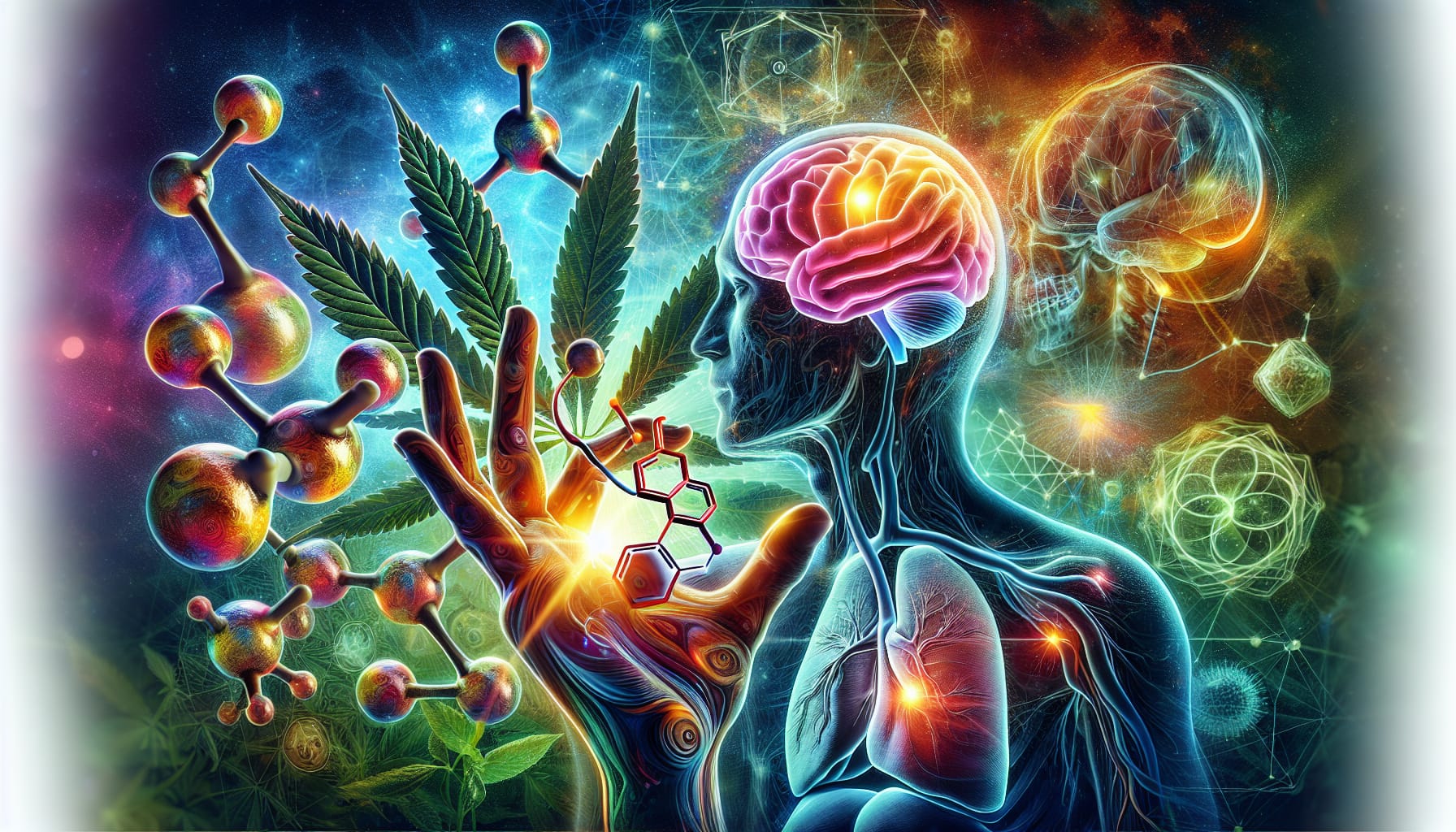In this article, you will discover how CBD, short for cannabidiol, interacts with the fascinating endocannabinoid system within your body. The endocannabinoid system, ECS for short, plays a crucial role in maintaining your overall well-being and balance. By understanding how CBD interacts with this system, you will gain insights into why it has gained so much popularity as a natural remedy. So, let’s explore the intricate relationship between CBD and your endocannabinoid system, and uncover the incredible benefits it can offer.
The Endocannabinoid System
Overview of the endocannabinoid system
The endocannabinoid system (ECS) is a complex network of receptors, neurotransmitters, and enzymes that plays a crucial role in maintaining homeostasis in the body. This system is involved in regulating a wide range of physiological processes, including mood, sleep, appetite, pain sensation, and immune function. The ECS consists of three main components: endocannabinoids, receptors, and enzymes.
Components of the endocannabinoid system
The ECS is comprised of endocannabinoids, which are naturally occurring cannabinoids produced by the body, as well as cannabinoid receptors and enzymes. The two primary endocannabinoids are anandamide (AEA) and 2-arachidonoylglycerol (2-AG). These endocannabinoids are synthesized on-demand and act as retrograde messengers, meaning they are produced by the postsynaptic neuron and travel backward to the presynaptic neuron to regulate neurotransmitter release.
There are two main types of cannabinoid receptors in the ECS: CB1 receptors, which are primarily found in the central nervous system, and CB2 receptors, which are mainly found in the peripheral tissues and immune cells. These receptors are responsible for mediating the effects of cannabinoids, including CBD.
Enzymes in the ECS are responsible for the breakdown and recycling of endocannabinoids. Two key enzymes in the ECS are fatty acid amide hydrolase (FAAH) and monoacylglycerol lipase (MAGL), which respectively break down anandamide and 2-AG.
Functions of the endocannabinoid system
The ECS has an extensive range of functions in the body, contributing to the regulation of various physiological processes. The primary role of the ECS is to maintain homeostasis, or balance, within the body. This system helps regulate mood, appetite, sleep, pain sensation, immune response, and inflammation. It also plays a vital role in neuroprotection, stress management, and memory formation.
CBD: An Introduction
Understanding CBD
CBD, short for cannabidiol, is a naturally occurring compound found in the cannabis plant. Unlike tetrahydrocannabinol (THC), CBD does not produce a psychoactive effect or “high” commonly associated with marijuana use. CBD has gained significant attention in recent years due to its potential therapeutic benefits and its interaction with the endocannabinoid system.
Different forms of CBD
CBD is available in various forms, including oils, capsules, edibles, topicals, and vape liquids. Each form of CBD has its own unique characteristics and may be preferred for different reasons. For example, CBD oil is commonly used sublingually (under the tongue) for fast absorption, while CBD topicals are applied directly to the skin for localized relief. The choice of CBD form depends on individual preferences and desired effects.
Legality of CBD
The legal status of CBD varies by country and jurisdiction. In many parts of the world, CBD extracted from hemp, a non-intoxicating variety of cannabis, is legal as long as it contains less than 0.3% THC. However, it is important to research and understand the specific laws and regulations regarding CBD in your location before purchasing or using any CBD products.
CBD and CB1 Receptors
Introduction to CB1 receptors
CB1 receptors are primarily found in the central nervous system, including the brain and spinal cord. These receptors are highly concentrated in regions involved in pain perception, mood regulation, and memory formation. CB1 receptors are G protein-coupled receptors that, when activated, inhibit the release of neurotransmitters, thereby modulating various physiological processes.
Interaction between CBD and CB1 receptors
CBD has been found to interact with CB1 receptors, although its mechanism of action is different from that of THC. Rather than directly binding to CB1 receptors, CBD acts as an allosteric modulator, meaning it influences CB1 receptor activity indirectly. CBD can modulate the binding affinity and signaling pathways of CB1 receptors, leading to various effects within the central nervous system.
Effects of CBD on CB1 receptors
CBD’s interaction with CB1 receptors has significant implications for its potential therapeutic effects. By modulating CB1 receptor activity, CBD may help regulate pain perception, mood, and memory. Additionally, CBD’s interaction with CB1 receptors has been suggested to contribute to its anxiolytic and neuroprotective properties.
CBD and CB2 Receptors
Introduction to CB2 receptors
CB2 receptors are predominantly found in peripheral tissues, particularly in immune cells. These receptors play a vital role in regulating inflammation and immune responses. CB2 activation can lead to anti-inflammatory effects and modulation of immune cell function.
Interaction between CBD and CB2 receptors
Like with CB1 receptors, CBD interacts with CB2 receptors in a modulatory manner. CBD can influence the signaling pathways and activation of CB2 receptors, dampening inflammatory responses and promoting immune homeostasis.
Effects of CBD on CB2 receptors
By interacting with CB2 receptors, CBD may help alleviate inflammation and support immune function. CBD’s modulatory effects on CB2 receptors have been studied for their potential in treating inflammatory conditions, autoimmune diseases, and other immune-related disorders.
CBD and Enzymes
Enzymes involved in the endocannabinoid system
Enzymes within the endocannabinoid system are responsible for the synthesis, breakdown, and recycling of endocannabinoids. FAAH and MAGL are the two primary enzymes involved in the breakdown of anandamide and 2-AG, respectively. These enzymes regulate the availability and duration of endocannabinoid signaling.
Inhibition of enzymes by CBD
CBD has been shown to inhibit the activity of FAAH and MAGL enzymes, resulting in increased levels of anandamide and 2-AG. By preventing the breakdown of endocannabinoids, CBD prolongs their effects and enhances their interaction with cannabinoid receptors, potentially leading to therapeutic benefits.
Impact of CBD on endocannabinoid breakdown
The inhibition of endocannabinoid breakdown by CBD contributes to its overall effects on the endocannabinoid system. By increasing the availability of endocannabinoids, CBD helps maintain ECS balance and promotes homeostasis. This inhibition also provides a potential explanation for CBD’s analgesic, anti-inflammatory, and immune-regulating properties.
CBD and Anandamide
Overview of anandamide
Anandamide, often referred to as the “bliss molecule,” is an endocannabinoid that binds to CB1 and CB2 receptors. It is involved in various physiological processes, including mood regulation, pain perception, and appetite. Anandamide is synthesized on-demand and broken down by FAAH enzymes.
Effects of CBD on anandamide
CBD has been shown to affect anandamide levels by inhibiting FAAH enzymes. By preventing anandamide breakdown, CBD increases its availability, leading to enhanced interaction with cannabinoid receptors. This interaction may contribute to the potential analgesic, anti-anxiety, and mood-elevating effects of CBD.
Mechanism of interaction between CBD and anandamide
CBD’s inhibition of FAAH enzymes prevents anandamide breakdown, allowing it to bind to and activate CB1 and CB2 receptors. This mechanism may explain how CBD promotes mood regulation, pain relief, and other effects associated with anandamide signaling.
CBD and 2-AG
Overview of 2-AG
2-AG, short for 2-arachidonoylglycerol, is another important endocannabinoid involved in the ECS. It primarily binds to CB1 and CB2 receptors and plays a role in regulating inflammation, immune function, and neuroprotection. 2-AG is synthesized on-demand and broken down by MAGL enzymes.
Effects of CBD on 2-AG
Similar to its effect on anandamide, CBD inhibits the breakdown of 2-AG by MAGL enzymes. By increasing 2-AG levels, CBD enhances its interaction with cannabinoid receptors, potentially exerting anti-inflammatory, immunomodulatory, and neuroprotective effects.
Mechanism of interaction between CBD and 2-AG
CBD’s inhibition of MAGL enzymes prevents the breakdown of 2-AG, allowing it to bind to CB1 and CB2 receptors. This interaction may underlie CBD’s ability to regulate inflammatory responses, support immune function, and promote neuroprotection through modulation of 2-AG signaling.
CBD and Other Receptors
Interaction between CBD and TRPV1 receptors
In addition to its interaction with CB1 and CB2 receptors, CBD can also influence other receptors in the body. One such receptor is the transient receptor potential vanilloid 1 (TRPV1) receptor, which is involved in pain perception and inflammation. CBD has been found to interact with TRPV1 receptors, potentially contributing to its analgesic and anti-inflammatory effects.
Interaction between CBD and serotonin receptors
CBD has been shown to affect serotonin receptors, particularly the 5-HT1A receptor. Activation of the 5-HT1A receptor has been associated with antidepressant and anxiolytic effects. CBD’s interaction with serotonin receptors may contribute to its potential therapeutic benefits in mood disorders, anxiety, and depression.
Interaction between CBD and adenosine receptors
CBD has also been found to interact with adenosine receptors, particularly the A2A receptor. Adenosine receptors play a role in regulating sleep, inflammation, and cardiovascular function. CBD’s interaction with adenosine receptors may contribute to its calming and anti-inflammatory effects, as well as its potential cardiovascular benefits.
Overall Effects of CBD on the Endocannabinoid System
Balancing the endocannabinoid system
By interacting with various components of the endocannabinoid system, CBD helps to maintain the balance and homeostasis of the body. It modulates the activity of CB1 and CB2 receptors, inhibits enzyme breakdown of endocannabinoids, and influences other receptors involved in pain, inflammation, mood, and sleep regulation. Through these interactions, CBD aims to restore equilibrium within the endocannabinoid system.
Potential therapeutic benefits of CBD
CBD’s interaction with the endocannabinoid system provides a foundation for its potential therapeutic benefits in a variety of conditions. Its analgesic, anti-inflammatory, anxiolytic, and neuroprotective properties may make it suitable for managing chronic pain, inflammation, anxiety disorders, epilepsy, and neurodegenerative diseases. However, further research is still needed to fully understand the extent of CBD’s therapeutic potential.
CBD as a modulator of the endocannabinoid system
CBD acts as a modulator of the endocannabinoid system, influencing the activity of receptors, enzymes, and neurotransmitters to regulate physiological processes. Its ability to maintain ECS balance and enhance endocannabinoid signaling contributes to its multifaceted effects on the body. CBD’s modulatory role in the endocannabinoid system sets it apart as a potentially valuable therapeutic compound.
Conclusion
The interaction between CBD and the endocannabinoid system is a complex and intricate process that influences various physiological functions within the body. By modulating the activity of CB1 and CB2 receptors, inhibiting enzyme breakdown of endocannabinoids, and interacting with other receptors, CBD aims to restore balance and promote homeostasis. This modulation of the endocannabinoid system underlies CBD’s potential therapeutic benefits, making it an intriguing area of research for scientists, healthcare professionals, and individuals seeking alternative remedies.





